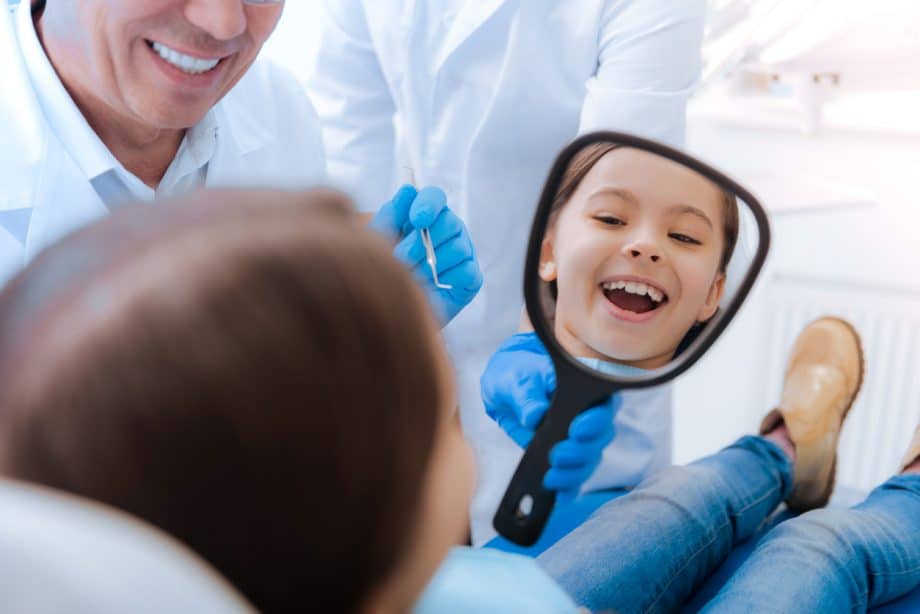Is your child in need of orthodontic treatment? You do not need a referral to know the answer. Schedule your free consultation with Dr. Seif and she will answer all your questions and will take care of your child at all levels. Orthodontics does not equal braces and there is a lot Dr. seif can do to prevent malocclusion or intervene with the existing one as early as 7 years of age. Waiting till your child has all his permanent teeth to consult with an orthodontic provider might make a simple issue more complicated.
When a child begins orthodontic treatment this early, it is sometimes divided into two phases. Phase I treatment is typically applied earlier in childhood and Phase II treatment occurs during the adolescent years. Both parts of two-phase orthodontics are equally important to ensure the best overall oral health.
Phase I Orthodontic Treatment
Orthodontic treatment in the early years is important for normal growth and development of jawbones and teeth. Some jaw problems need to be treated while the child is still growing “during growth spurt”. This stage completed early while the child still have mixed dentition (baby teeth and adult teeth)
During Phase I of orthodontic treatment, Dr. Seif’s goal is to treat jaw misalignment, horizontal and vertical bit problems, dental arch expansion, and bad dental habits, that if left untreated, may produce undesirable effects on child’s appearance and self-esteem in critical age of life.
Orthodontic Interventions Used During Phase I Include:
- Space supervision: When teeth are crowded due to lack of room in the jaw, Dr. Seif uses very simple treatment techniques based on her knowledge of dental development to create space to accommodate every erupting adult tooth so that the child will never suffer from badly looking crooked teeth, until it is time for braces.
- Habit breakers: If the child is a thumb sucker, this habit has a bad effect on the growth and development of his teeth and jawbones. A simple appliance that needs no compliance can be fabricated to get rid of this habit.
- Mouth Breathing: If the child is snoring and/or grinding at night, does not score well in school, has behavioral issues and falls asleep during the day he might be a mouth breather. Dr. Seif can do airway analysis, treat the oral symptoms and refer the child to a specialist to address the root causes.
- Space maintainers. Sometimes primary teeth come out or are removed before permanent teeth are ready to come in. Space maintainers can hold the place so the permanent teeth will have room to come incorrectly.
Phase II Orthodontic Treatment
The goal of the second phase of orthodontic treatment is to have adult teeth in the ideal position. Braces may be applied as early as 10 or 11 years old depending on the severity of the need. Other forms of orthodontic treatment may be used before, after, or in conjunction with braces to achieve the best possible results.
Orthodontic Treatments Used in Phase II Include:
- Braces. Traditional metal braces may be used to align the teeth and bite. Braces are typically worn anywhere from 1-3 years when instructions are followed and appointments are kept.
- Clear Braces. For patients who want more subtle orthodontic treatment, clear braces are less visible. They still successfully align teeth and bite patterns in about the same timeframe as metal braces.
- Invisalign. An alternative to traditional braces, Invisalign uses a series of clear plastic aligners to straighten teeth and correct bite problems. They are less visible, can be removed to eat and brush teeth, and are comparable in price to traditional braces. The patient must simply follow the orthodontic provider's instructions for changing out retainers and come in for periodic visits to check progress.
- Surgery. For some patients, Phase II orthodontics includes oral surgery such as tooth extractions, jaw surgery, and tooth retrieval when permanent teeth fail to erupt. Oral surgery will often happen in conjunction with braces or other orthodontic treatments.
- Retainers. After orthodontic treatment is complete, retainers are a very necessary follow-up. Patients must wear retainers to maintain the alignment of the teeth and bite that all those months and years of braces and other orthodontic treatments have achieved. Failing to wear retainers could result in repeating treatment.
Castle Hills 3D Orthodontics Offers Two-Phase Treatment
Proper orthodontic treatment should be an ongoing process throughout a child’s growth and developmental years. Seeing an orthodontic provider as early as 7 years old can start them on the right road to a lifetime of proper oral health. Phase I orthodontics is the foundation for Phase II orthodontics that achieves the best possible results.
Castle Hills 3D Orthodontics offers the necessary orthodontic support every step of the way to achieve a beautiful smile. Call (469) 598-1700 today to schedule a consultation or request an appointment.

